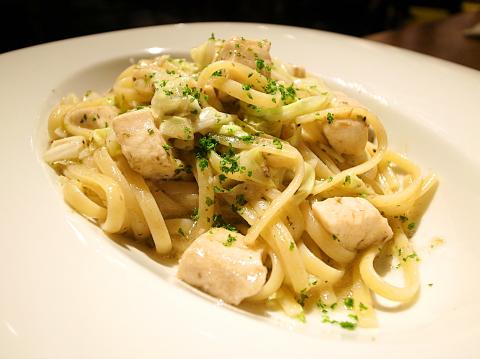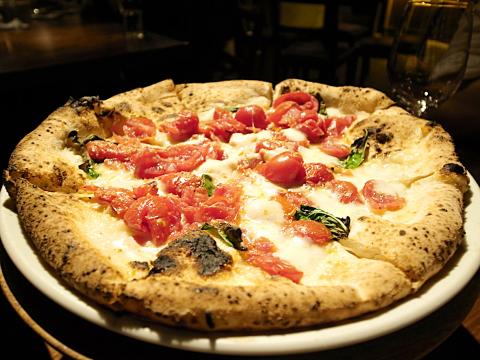In Taipei, where handmade pizza experienced a boom and has become the new norm in the restaurant scene, Salvatore Cuomo & Bar, an international chain restaurant from Japan, creates the latest buzz with the much-touted, award-winning pies that have spread across its birth country and to China and South Korea. A recent weekday visit shows that the restaurant is off to a good start, wooing diners with a lively vibe, hearty food and attentive service.
Interestingly, the newcomer, located inside the Breeze Center (微風廣場), has a hybrid feel that reflects its provenance. Shepherded by Italian-Japanese grand chef Salvatore Cuomo, the establishment sports a quintessential Italian menu featuring choices of antipasto, pizza and pasta dishes, while the Taiwanese and Japanese waiting staff greet customers in unison as if in a Japanese restaurant. Outfitted with a well-arrayed, open kitchen where young cooks wearing black bandana and in white uniforms are busy preparing food, the interior exudes an industrial urban chic, tempered by brick walls and warm earth tones. Service is attentive, and the couple of wait persons who served our table were quick and helpful for making recommendations.
My dining companions and I started our supper with the assorted buffalo mozzarella cheese and cherry tomato (NT$600), said to be one of the best choices to savor the restaurant’s famous, high-quality buffalo mozzarella, produced in Italy specifically for Cuomo’s culinary enterprise. Made from water buffalo milk, the cheese is soft, springy in texture and has a delicate, mild taste that is fragrantly creamy and never cloyingly rich.

Photo: Ho Yi, Taipei Times
The romaine lettuce and egg salad (NT$320), on the other hand, was small and didn’t impress with the mushy vegetables.
Then comes the evening highlight: D.O.C (NT$700), Cuomo’s rendition of Neapolitan pizza that won top award at the Pizzafest, a world pizza championship held in Naples. With simple offerings of cherry tomato, basil and buffalo mozzarella, the pie makes simplicity tasteful, with the thin crust baked to a slightly crispy brown on the rim, while maintaining a satisfyingly buttery and chewy texture toward the center. But if diners don’t dive into the pizza right away, the crust tends to get soggy and can barely hold the toppings.
We also tried both the prosciutto and rucola (NT$750), topped with tomato sauce, buffalo mozzarella, smoked cheese, prosciutto ham, rocket greens and Parmesan, and bismark (NT$600), which comes with bacon, ham, spinach, mushrooms, semi-cooked egg and buffalo mozzarella. Both were good, but had the same problem of the soggy crust.

Photo: Ho Yi, Taipei Times
For pasta, we ordered the linguine aglio olio with swordfish and cabbage (NT$470), which my dining companions agreed was a bit too salty. Gnocchi and risotto are also on offer, while dishes like Neapolitan soup of seasonal seafood and fresh fish (NT$1,100) completes the restaurants’ southern Italian flavors.
To round off a hearty meal at Salvatore Cuomo & Bar, diners have several sweet options including tea-flavored panna cotta with fresh fruit sauce (NT$220), tiramisu (NT$220) and organic milk gelato topped with rich espresso sauce (NT$250).
Tipplers will be happy to know that Salvatore Cuomo & Bar has an extensive wine list made up of sparkling, white and red wines from Italy, France, German, Spain, Chile, Australia, New Zealand and the US (NT$230 to NT$280 by glass, NT$880 to NT$5,380 by bottle), along with a selection of beer and cocktails.

Photo: Ho Yi, Taipei Times
While the ambience of the restaurant is convivial for drinkers, one of my dining partners rightfully complained that the music played on the evening we visited was too loud and clubby, making it difficult for customers to relax and enjoy the food.
The restaurant offers lunch buffet that costs NT$500 on weekdays and NT$600 on weekends per head, plus 10 percent service charge. Only a la carte menu is available in the evening.

Photo: Ho Yi, Taipei Times

Photo: Ho Yi, Taipei Times

Exceptions to the rule are sometimes revealing. For a brief few years, there was an emerging ideological split between the Democratic Progressive Party (DPP) and Chinese Nationalist Party (KMT) that appeared to be pushing the DPP in a direction that would be considered more liberal, and the KMT more conservative. In the previous column, “The KMT-DPP’s bureaucrat-led developmental state” (Dec. 11, page 12), we examined how Taiwan’s democratic system developed, and how both the two main parties largely accepted a similar consensus on how Taiwan should be run domestically and did not split along the left-right lines more familiar in

As I finally slid into the warm embrace of the hot, clifftop pool, it was a serene moment of reflection. The sound of the river reflected off the cave walls, the white of our camping lights reflected off the dark, shimmering surface of the water, and I reflected on how fortunate I was to be here. After all, the beautiful walk through narrow canyons that had brought us here had been inaccessible for five years — and will be again soon. The day had started at the Huisun Forest Area (惠蓀林場), at the end of Nantou County Route 80, north and east

Specialty sandwiches loaded with the contents of an entire charcuterie board, overflowing with sauces, creams and all manner of creative add-ons, is perhaps one of the biggest global food trends of this year. From London to New York, lines form down the block for mortadella, burrata, pistachio and more stuffed between slices of fresh sourdough, rye or focaccia. To try the trend in Taipei, Munchies Mafia is for sure the spot — could this be the best sandwich in town? Carlos from Spain and Sergio from Mexico opened this spot just seven months ago. The two met working in the

This month the government ordered a one-year block of Xiaohongshu (小紅書) or Rednote, a Chinese social media platform with more than 3 million users in Taiwan. The government pointed to widespread fraud activity on the platform, along with cybersecurity failures. Officials said that they had reached out to the company and asked it to change. However, they received no response. The pro-China parties, the Chinese Nationalist Party (KMT) and Taiwan People’s Party (TPP), immediately swung into action, denouncing the ban as an attack on free speech. This “free speech” claim was then echoed by the People’s Republic of China (PRC),